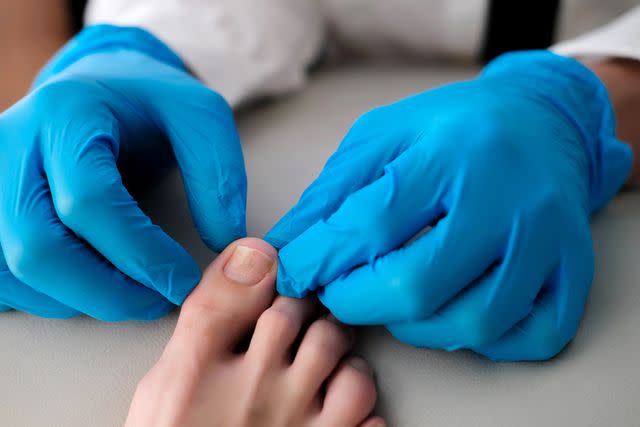What Is a Toe Infection?
Toe infections are common. They cause many unpleasant symptoms and can lead to complications if not treated properly or quickly enough. Types of toe infections include a range of bacterial or fungal infections.
This article overviews common toe infections, symptoms, causes, prevention, diagnosis, and treatment options.

Irina Tiumentseva / Getty Images
Toe Infection Symptoms
Symptoms of a toe infection may include:
Pain or soreness
Redness in the affected area
Fever
Feelings of warmth
Discolored skin or nails
A pus-filled blister
Thick, fragile, or cracked nails
Difficulty walking due to discomfort
Seek medical attention if any of these symptoms are present. It is important to note that the type of infection you have determines your symptoms.
Causes
There are many potential causes for infected toes, and they most commonly stem from a fungal or bacterial infection.
Fungal Toe Infections
Fungal toe infections are a type of infection in which a fungus grows in and around the toenail.
Two of the most common fungal infections of the toe include:
Toenail fungus, also known as onychomycosis.
Athlete's foot, or tinea pedis: Commonly affects the space between the toes but can spread throughout the foot and toenails.
Fungi can live on the outer layers of the skin or on dead tissues of the hair or nails. Fungal toenails often stem from fungal infections on the feet and occur more commonly as people age.
People get fungal infections of the toe and toe nail from walking on damp surfaces or walking barefoot in public showers, pools, and bathroom floors.
Some people are more likely to get fungal toe infections than others, including adults or the elderly, and people with the following conditions:
An injury or trauma to the nail
Cutting a nail too short
Lower immune system due to illness or autoimmune disease
Venous insufficiency (poor circulation)
A fungal infection somewhere else on the body
Athletes
Chemotherapy patients
Preventing fungal foot infections is possible through the following:
Wearing clean socks
Keeping feet clean and dry
Not walking barefoot in public areas, especially bathrooms and locker rooms
Wearing flip-flops in public bathing and showering areas
Bacterial Infections
Bacterial infections in the toe are less common than fungal infections but can become very serious. If left untreated, a bacterial toe infection that enters the bloodstream can cause an extreme response called sepsis, which is a life-threatening medical emergency.
Bacterial infections start due to a break in the outer layer of the skin or other injuries. For example, an ingrown toenail can damage the skin around the toenail and cause a bacterial infection.
Types of bacterial infections in the toe include:
Cellulitis: A common bacterial skin infection that causes redness, pain, and swelling
Erythrasma: A bacterial infection that appears like a discolored patch often occurs in skin folds or between the toes.
Paronychia: An infection around a toenail that causes swelling, redness, pus, and pain.
Abscess: an infection of the soft tissue that causes the pooling of pus beneath the skin.
Osteomyelitis: A bacterial infection that affects the bone.
Bacterial infections that can affect the toes are more common in people who:
Have poor circulation
Have diabetes
Are older age
Are malnourished
Have a weakened immune system due to taking medicines that suppress the immune system
Have human immunodeficiency virus (HIV) or other autoimmune diseases
Diagnosis
You need to see a healthcare provider for a diagnosis. Types of providers that commonly make this type of diagnosis include primary care providers, dermatologists, and podiatrists.
Your healthcare provider will typically perform a physical examination and take note of any symptoms. In most cases, they can make a diagnosis with a visual examination. They usually won't require diagnostic tests and X-rays. However, in rarer cases, they may order imaging scans such as:
Your provider may also order blood testing to confirm the diagnosis and to rule out other conditions. In addition, they may also collect a sample of fluid or tissue from the affected toe to examine in a lab.
When healthcare providers confirm a diagnosis, either visually or through testing, they can tailor treatment options to your specific infection.
Treatment
Treatment for an infected toe depends on the type of infection. Fungal and bacterial infections require different treatments and medications.
Treatment for a fungal infection of the toe includes:
Trimming any affected nails. In some cases, your healthcare provider may scrap away debris under the nail
Topical fungal infection medications, which may consist of (Odenil) amorolfine, Loprox (ciclopirox), or Jubila (efinaconazole)
Antifungal oral pills such as Diflucan (fluconazole), Gris-PEG (griseofulvin), or Terbinafine
Nail removal in cases of severe infections or not responding to therapy
Nail fungus can be hard to clear and take several months to go away. Sometimes the entire nail must grow out, which can take 12–18 months. Also, healthcare providers may choose a combination of therapies to treat a fungal infection more effectively.
Treatment for a bacterial infection of the toe includes:
Topical ointment or cream antibiotic medication
Oral antibiotic medication
If the bacterial infection contains pus, treatment may include draining the pus
Summary
Toe infections can cause uncomfortable and unpleasant symptoms such as redness, swelling, pain, itching, and discharge. If left untreated or undetected early enough, these infections can lead to more severe health issues or spread to other body parts.
The great news is that you can manage toe infections effectively with proper treatment and care. It is important to promptly address any toe infection symptoms with your healthcare provider to prevent worsening or further complications.

